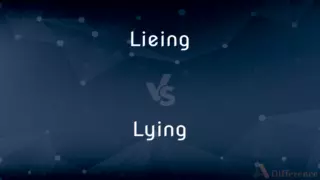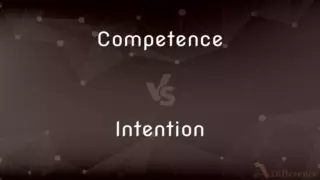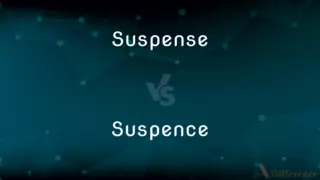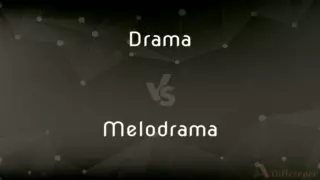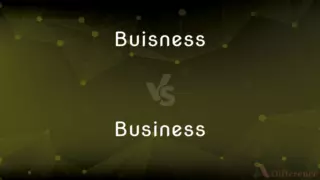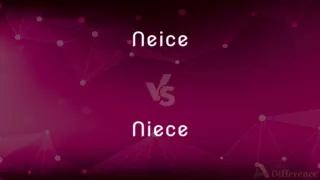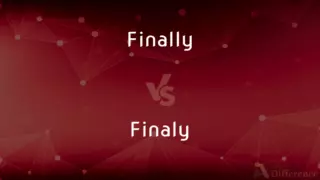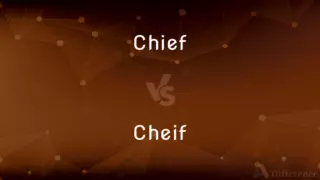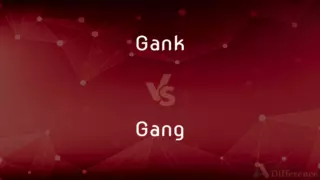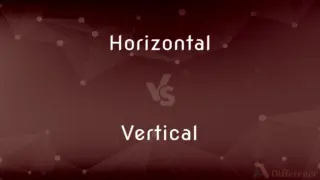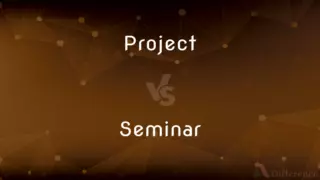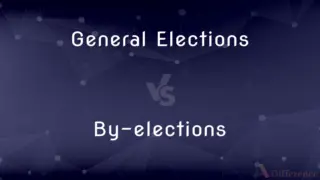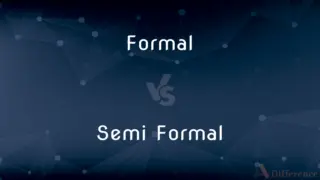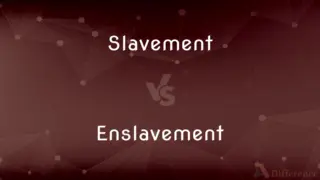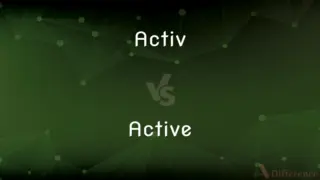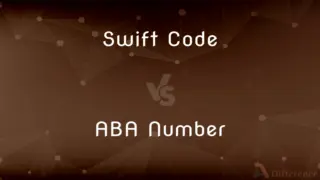Bill of Exchange vs. Promissory Note — What's the Difference?
By Tayyaba Rehman — Published on October 22, 2023
A Bill of Exchange involves three parties and orders one party to pay a specified sum to a third party, whereas a Promissory Note involves two parties and contains a promise by the maker to pay a sum to the payee.

Difference Between Bill of Exchange and Promissory Note
Table of Contents
ADVERTISEMENT
Key Differences
Furthermore, a Bill of Exchange can be drawn in sets, meaning there can be more than one copy of the bill, each being equally valid for claiming payment. This feature is notably absent in a Promissory Note, which is singular and explicitly binds the person making the note to the promise of payment, without necessitating duplicate documentation.
Tayyaba Rehman
Oct 22, 2023
Distinguishing between a Bill of Exchange and a Promissory Note can be dissected through understanding their inherent financial and contractual nature. A Bill of Exchange typically encompasses three entities: the drawer, the drawee, and the payee. The conversational dynamics of a Promissory Note, on the other hand, traditionally involves two parties: the maker and the payee, rendering it a more straightforward instrument.
Tayyaba Rehman
Oct 22, 2023
One of the primary distinctions is that a Bill of Exchange is essentially an order made by the drawer to the drawee to pay money to a third-party payee. Alternatively, a Promissory Note is a commitment, where the maker directly promises to pay a specified amount of money to the payee on a particular date or on-demand, minimizing external interaction.
Tayyaba Rehman
Oct 22, 2023
Legalities and obligations within a Bill of Exchange inherently require acceptance from the drawee, signaling an agreement to adhere to the order. In contrast, a Promissory Note does not necessitate such acceptance, since the individual who creates the note (maker) is the person obligated to pay, streamlining the process and eradicating the need for intermediate approval.
Tayyaba Rehman
Oct 22, 2023
While a Bill of Exchange presents an order and a Promissory Note articulates a promise, they mutually navigate the realm of financial transactions, facilitating a structured, documented, and thus, a secured way of dealing with monetary matters amidst parties involved, ensuring a lawful means of addressing potential disputes or discrepancies.
Tayyaba Rehman
Oct 22, 2023
ADVERTISEMENT
Comparison Chart
Parties Involved
Involves three parties: drawer, drawee, and payee
Involves two parties: maker and payee
Tayyaba Rehman
Oct 22, 2023
Liability
Drawee is primary; drawer is secondary liable
Maker is primary liable
Tayyaba Rehman
Oct 22, 2023
ADVERTISEMENT
Definitions
Bill of Exchange
A Bill of Exchange involves three distinct entities.
In the Bill of Exchange, the drawer directed the drawee to remit funds to the payee.
Tayyaba Rehman
Oct 05, 2023
Promissory Note
A Promissory Note is a promise by one party to pay another.
The maker issued a Promissory Note, vowing to pay the university.
Tayyaba Rehman
Oct 05, 2023
Bill of Exchange
A Bill of Exchange requires the drawee's acceptance.
The drawee signed the Bill of Exchange, validating its order.
Tayyaba Rehman
Oct 05, 2023
Promissory Note
A Promissory Note straightforwardly binds the maker to payment.
The Promissory Note unequivocally obligated her to fulfill the payment.
Tayyaba Rehman
Oct 05, 2023
Bill of Exchange
A Bill of Exchange commands a party to pay a third party.
The drawer issued a Bill of Exchange instructing the bank to pay the supplier.
Tayyaba Rehman
Oct 05, 2023
Promissory Note
A Promissory Note does not demand acceptance from the payee.
The maker's signature validated the Promissory Note without needing payee acceptance.
Tayyaba Rehman
Oct 05, 2023
Bill of Exchange
A Bill of Exchange can be formulated in sets.
Multiple sets of the Bill of Exchange were circulated amongst involved parties.
Tayyaba Rehman
Oct 05, 2023
Promissory Note
A Promissory Note is not drawn in sets.
The single Promissory Note was kept securely due to its uniqueness and value.
Tayyaba Rehman
Oct 05, 2023
Bill of Exchange
The drawer in a Bill of Exchange is secondarily liable.
Upon non-payment by the drawee, the drawer on the Bill of Exchange becomes liable.
Tayyaba Rehman
Oct 05, 2023
Promissory Note
A Promissory Note encompasses two parties: maker and payee.
He was obligated to pay according to the terms of the Promissory Note.
Tayyaba Rehman
Oct 05, 2023
FAQs
How many parties are involved in a Bill of Exchange?
A Bill of Exchange involves three parties: the drawer, drawee, and payee.
Tayyaba Rehman
Oct 22, 2023
Can a Bill of Exchange be drawn in sets?
Yes, a Bill of Exchange can be issued in multiple sets.
Tayyaba Rehman
Oct 22, 2023
Is acceptance required in a Bill of Exchange?
Yes, the drawee must accept the Bill of Exchange for it to be valid.
Tayyaba Rehman
Oct 22, 2023
What is the nature of a Promissory Note?
A Promissory Note is a financial instrument where the maker promises to pay the payee a certain amount.
Tayyaba Rehman
Oct 22, 2023
Does a Promissory Note involve a drawee?
No, a Promissory Note involves only the maker and the payee.
Tayyaba Rehman
Oct 22, 2023
Who has the liability to pay in a Bill of Exchange?
Initially, the drawee has the liability, but if they fail to pay, the drawer becomes liable.
Tayyaba Rehman
Oct 22, 2023
Is it possible to transfer a Promissory Note to another party?
Yes, a Promissory Note can often be transferred, but specifics might depend on jurisdiction and specific terms.
Tayyaba Rehman
Oct 22, 2023
What happens if a drawee refuses to accept a Bill of Exchange?
If refused, the Bill of Exchange can be noted or protested for non-acceptance.
Tayyaba Rehman
Oct 22, 2023
Who orders the payment in a Bill of Exchange?
The drawer orders the payment in a Bill of Exchange.
Tayyaba Rehman
Oct 22, 2023
Who promises to pay in a Promissory Note?
The maker promises to pay in a Promissory Note.
Tayyaba Rehman
Oct 22, 2023
How many documents are there in a Promissory Note transaction?
There is only one document in a Promissory Note transaction.
Tayyaba Rehman
Oct 22, 2023
Can a Bill of Exchange be used in international trade?
Yes, a Bill of Exchange is often used in international trade.
Tayyaba Rehman
Oct 22, 2023
Is a Promissory Note internationally recognized?
While it can be used in international contexts, its acceptance and utilization might vary.
Tayyaba Rehman
Oct 22, 2023
In what scenarios is a Promissory Note typically utilized?
Promissory Notes are often used in business transactions and personal loans.
Tayyaba Rehman
Oct 22, 2023
What is the validity period of a Bill of Exchange?
The validity of a Bill of Exchange might be determined by specific terms or relevant jurisdictional regulations.
Tayyaba Rehman
Oct 22, 2023
Author Spotlight

Written by
Tayyaba RehmanTayyaba Rehman is a distinguished writer, currently serving as a primary contributor to askdifference.com. As a researcher in semantics and etymology, Tayyaba's passion for the complexity of languages and their distinctions has found a perfect home on the platform. Tayyaba delves into the intricacies of language, distinguishing between commonly confused words and phrases, thereby providing clarity for readers worldwide.



